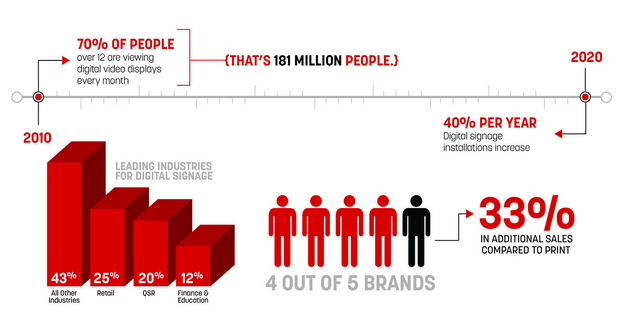WHY IS DIGITAL SIGNAGE USE INCREASING?

More companies are embracing the cost-effective opportunities offered by new dynamic advertising technology. Companies with digital signage are more likely to get customers in the store, direct them to more areas of the store and increase customer time in the store. Multiple studies prove the strong ROI and ROO of digital signage systems.
In 2010, Nielson tracked digital signage use in 120 grocery stores over time and found that 4 out 5 brands experienced increases of up to 33% in additional sales compared to when using printed signage alone(5). Also, 68% of customers agreed that digital signage would “influence their decision to buy the advertised product in the future” and 44% agreed it would “influence them to buy the advertised product instead of one they planned to buy.”(6)
With digital signage, messages can be changed on demand with very low cost (unlike printed signage), so companies can speak directly to their customer with the right message, in the right place and at the right time. Companies can switch menu items and products according to the time of day, season or available inventory with ease. They can also showcase more products and information than ever before with multiple features in a slideshow format, and enhance the in-store experience by engaging customers and creating dynamic interior decor.
(http://us.moodmedia.com/data-behind-digital-signage)
70% of US residents 12 and older have seen a digital video display in a public venue in the past month, 52% recall seeing one in the last week.
Digital video in public venues reaches more Americans each month (70%) than video over the internet (43%) or Facebook (41%)
The top 5 places consumers with are grocery stores (28% of the US population 12 and older), Shopping malls (27%), large retail or department stores (20%), medical offices (20%) and movie theatres (19%).
Viewers are engaged with the content; nearly half (47%) of those who have seen a digital place-based video in the past month specifically recall seeing the ad.
Digital Video ads have an effect on purchase patterns. Nearly one in five (19%) of those who have seen a digital video ad said the made an unplanned purchase after seeing an item featured on the screen.
http://www.rnrmarketresearch.com/global-digital-signage-dynamic-signage-electronic-signage-narrowcasting-market-by-components-applications-displays-geography-2011-2016-market-report.html:
The global digital signage market was valued at $14.63billion in 2014 and is expected to reach$23.76billion by 2020, at a CAGR of 8.18% between 2015 and 2020. In terms of geography, North America accounted for the major market share of ~34% in 2014, followed by Europe with ~29%. APAC is projected to grow at the highest CAGR of 9.34% between 2015 and 2020.
http://www.digitalsignagetoday.com/news/nielsen-study-dooh-increases-revenue-at-the-point-of-sale-2/:
Four out of five product brands experienced significant increases of up to 33 percent in additional sales through the use of DOOH media.
At the same time, display screen advertising at the POS considerably increased brand awareness: While previous studies on the effectiveness of POS advertising media showed only a slight increase in brand awareness (unprompted), the in-store TV tested here yielded a remarkable increase in awareness and recall rates of up to 14 percent (unprompted) and 31 percent (prompted).
Conscious awareness of digital display screens is generally high, according to the Nielsen study. Roughly three quarters of those surveyed (74 percent) noticed the monitors at the POS. The awareness rate for DOOH media is thus 23 percent higher than the average benchmark of other POS media analyses. In-store TV also gets good marks when it comes to acceptance: Display screen advertising and infotainment while shopping were well received by 62 percent of consumers.
Signstix

